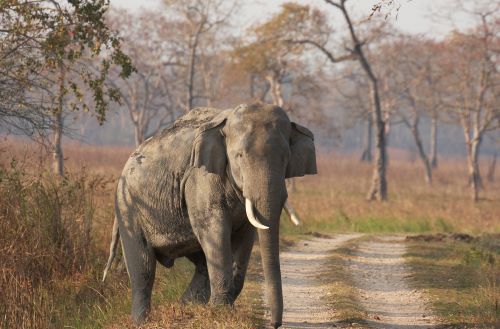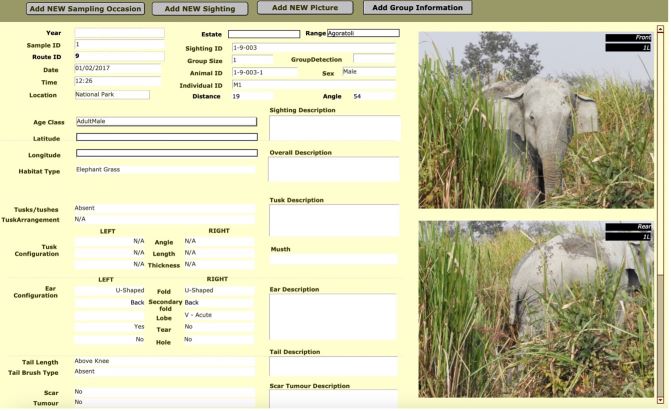
Kaziranga National Park in Assam, India harbors one of the largest populations of Asian elephants in the world. Here, a dedicated team of researchers has embarked on an extraordinary initiative that’s redefining the ways we understand and safeguard these majestic creatures.
Supported by Claris FileMaker technology, this initiative has evolved into a sophisticated and impactful approach for wildlife research and conservation, offering hope for India’s elephant population.
This story shows how a dedicated team turned innovative strategies and their technology vision into reality, with a FileMaker solution that helps to ensure elephant populations thrive while fostering harmony with local communities.
The challenge: Balancing complexity and conservation.
Effective conservation strategies require accurate assessment of elephant numbers, their population dynamics, health, and movements. Traditional counting methods often led to underestimation and other forms of bias, which resulted in missing critical insights on elephant populations.
The research team needed a sophisticated system that could handle complex data and tens of thousands of photographs, while being easy to use for field researchers.
Innovative approach to elephant identification.
With the pioneering efforts of Dr. Varun R. Goswami, co-founder and director of Conservation Initiatives, the NGO introduced a cutting-edge approach to elephant monitoring—a comprehensive photographic database powered by FileMaker.
The visual solution allows researchers to individually identify elephants and estimate population size and other key parameters using robust statistical tools. FileMaker transformed a once-cumbersome process into an efficient, streamlined workflow, unlocking new insights into elephant populations.
According to Parvathi K. Prasad, a scientist at Conservation Initiatives, “FileMaker's greatest strength is its ability to integrate all aspects of our data into a single, customizable view, making it easier for us to manage large volumes of data.”
"FileMaker's greatest strength is its ability to integrate all aspects of our data into a single, customizable view, making it easier for us to manage large volumes of data."
— Parvathi K. Prasad, scientist at Conservation Initiatives

Recognizing that each elephant possesses a unique combination of physical characteristics—much like human facial features—the team developed a sophisticated method for individual identification. Using detailed photographs to record distinctive features, such as ear shape, tusk configuration, and tail markings, researchers created a dynamic photo database that documents a rich portrait of elephant life.
This meticulous approach involves a multistage process:
- Comprehensive photography: The team photographs every elephant encountered during extensive multi-year surveys.
- Database integration: These photographs are meticulously logged into the FileMaker database.
- Individual identification: Researchers document unique characteristics, creating individual profiles for each elephant.
- Population monitoring: Information recorded in the database is combined with statistical tools to estimate elephant population and movement parameters.
- Behavioral monitoring: Sightings, group associations, and movement patterns are recorded, enriching the individual elephant profiles.

Far more than simple photographic records, the information has become a living, breathing database that provides crucial information on individual elephant identities, behaviors, and movements, enabling a deeper understanding of the animals’ lives and challenges faced.
Beyond the numbers: A holistic conservation approach.
This FileMaker solution is now an indispensable tool, enabling researchers to unlock profound insights into elephant behavior, population dynamics, and human-elephant interactions, such as:
- Tracking elephant behaviors: Mapping movements of elephants reveals habitat preferences, conservation needs and responses to environmental change.
- Long-term monitoring of individual elephants: Tracking individual elephants over multiple years provides insights into life trajectories, social dynamics, and behavioral changes.
- Population assessments: Examining population changes over time helps the team understand elephant responses to environmental changes.
- Learning social dynamics: Deciphering the complex social dynamics within elephant herds sheds light on family structures and social interactions.
- Human-elephant conflict mitigation: Assessing potential human-elephant conflicts leads to strategies that ensure the safety of both people and wildlife.
- Inform on-ground management: All of the above tactics can inform on-ground management and shape effective design of conservation strategies.
This work extends beyond the confines of Kaziranga National Park. It supports research on how elephants navigate human-dominated landscapes, such as tea estates in India that serve as critical corridors connecting fragmented habitats and bringing elephants into contact with people living in local communities.
How FileMaker revolutionized the workflow.
The custom app has digitally transformed the research process, resulting in:
- Streamlined data management: The solution provides streamlined data management through a centralized digital repository that organizes and stores comprehensive elephant data from photographs and precise physical characteristics, enabling efficient tracking, analysis, and retrieval.
- Accurate population estimates: Regular surveys combined with photo identification provides reliable population estimates, crucial for assessing the health and trends of the elephant population.
- Efficiency in identification: By creating filters for specific morphological features, the custom application narrows down potential matches, allowing faster comparisons of photographs and reducing manual effort.
- Long-term monitoring: The custom app enables long-term monitoring, providing critical insights into elephant behavior and population trends over time.
- Enhanced collaboration: The solution facilitates seamless collaboration, allowing stakeholders to share and insights, and collectively contribute to elephant conservation efforts.
To further enhance their FileMaker solution, Conservation Initiatives is investigating the future use of semantic search. With this AI feature, their users could ask the custom app all sorts of questions—even if they don’t know exactly what to ask or how to find it—then get immediate answers from existing data.
For example, a researcher could ask to see all photos of “elephants by a river” and get them displayed in a matter of moments, even if the database doesn’t include a body of water in the photo descriptions. This semantic search functionality would greatly shorten the time it takes someone to sift through tens of thousands of photos. Learn more.
Contributions to human-wildlife coexistence.
The project’s success extends beyond pure research. By training local forest staff and sharing data with relevant stakeholders, the conservation team has fostered stronger collaboration between scientists, government agencies, and local communities. This collaborative approach has created more effective conservation strategies and more informed decision-making.
One of the most significant achievements of the project is its contribution to human-elephant coexistence. The team collaborated with local communities to foster coexistence and promote sustainable practices, ensuring the well-being of both humans and elephants. This collaborative approach has been instrumental in creating a harmonious relationship between elephant and human populations, making the local conservation efforts more sustainable and effective.
Extending this FileMaker solution beyond elephant conservation.
What began as a research and technological vision has become a valuable tool for Asian elephant population monitoring and protection. By combining FileMaker technology, rigorous scientific methodology, and a profound respect for wildlife, Conservation Initiatives has pioneered new digital strategies in conservation research.
This preservation approach has even more potential. While currently focused on Asian elephants in India, the methodology could easily be adapted for other species, offering a blueprint for additional wildlife conservation worldwide.
Note of thanks: Winsoft International has been a valued partner of Claris for more than 20 years, helping expand our reach through localising and distributing our software in India, Central and Eastern Europe, the Middle East, and Africa. We’re grateful to them for making us aware of this compelling FileMaker use case and for their collaboration with Conservation Initiatives in organising the content and bringing the story to life.